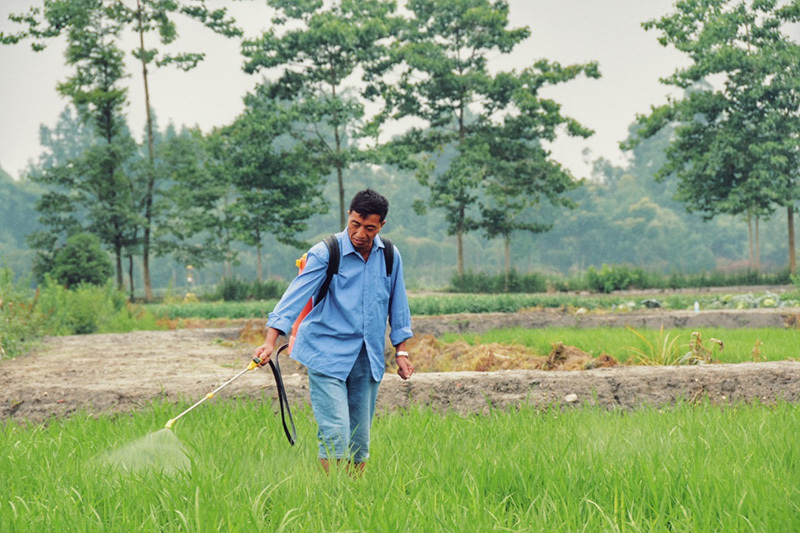Recommended scheme for green rice prevention and control [popular version]
Release time :
2018-08-13
This plan is mainly the plant protection measures for disease and pest control after rice transplanting into the field. The bactericide in the plan can be mixed with 421, but there are restrictions from the manufacturer. Not all manufacturers of Bacillus subtilis and Jinggangmycin can be mixed; Please consult for specific mixing.

Photographer/Yang Kun
1、 Product features:
Metarhizium anisopliae CQMa421 dispersible oil suspension agent is a patented biological pesticide product developed by our company for the control of various pests. The effective ingredient of this insecticide is Metarhizium anisopliae CQMa421 (patent No. CN201510084106.9). The preparation developed based on this strain has better broad-spectrum, better stability and stronger resistance, and is a new generation of more efficient fungal biological insecticide. It is harmless to fish, shrimp, crab and poultry, does not pollute the environment, does not kill natural enemies, and is friendly to the environment. Metarhizium anisopliae originates from the environment and then returns to the environment, so it will not cause harm to the environment. It can be said that it originates from nature and belongs to nature.
2、 Action mechanism:
Metarhizium anisopliae CQMa421 infects pests by contacting their body walls under natural conditions, grows and propagates in the body of pests, and kills pests by depleting their nutrients or secreting toxins.
3、 Usage:
1. Pest control indicators should be less than chemical pesticides (early prevention and small prevention). Rice planthopper: the pesticide shall be applied when the amount of insects in the field is 200-400 heads/100 clumps; Chilo suppressalis: before transplanting and from the peak of adult to the peak of egg hatching (dry sheath stage); Rice leaf roller: 5-8 days after the moth peak or from the beginning of egg hatching to the peak.
2. The recommended dosage for single use is 80ml/mu, the dosage can be increased if the population base is large, and the large dosage is also safe for rice; In case of explosive pest, it can be mixed with chemical pesticides, and the recommended dosage of mixed use is 40ml/mu+20% - 50% of the dosage of chemical pesticides per mu, in order to improve the efficiency and reduce pesticide residues.
3. The solution was prepared by twice dilution method to spray the target crops. This product needs to be mixed with water for initial dilution before use. 40ml (ml) oil suspension is mixed with 40ml (ml) water to the scale line and shaken evenly. The shaking standard is that there is no dark green substance attached to the bottle wall; Then add water to the shaken solution for secondary dilution as required.
4. If mixed with other agents, first add other agents and dilute with water, and finally add the twice diluted Metarhizium anisopliae CQMa421 dispersible oil suspension agent.
5. This drug infects pests by contact, so it needs to be sprayed on the insect body or the surface of plants that are easy to contact with pests.
4、 Precautions:
1. As the medicament is contact killing and has no internal absorption effect, spray shall be as comprehensive as possible. When using, try to spray the pesticide on the insect body or on the plant surface that can be easily contacted with the insect. Because Chilo suppressalis and rice leaf roller focus on rice leaf; The rice planthopper applied pesticide on the rice stem, namely the middle and lower part.
2. The spraying time should be after 4pm on sunny days, and it can be sprayed all day on cloudy days. The temperature is 25-28 ℃. The water temperature shall not be higher than 30 ℃ when dispensing. It is necessary to spray once in case of rain 1-2 days after spraying.
3. The biological insecticide is a fungal living insecticide, which cannot be mixed with alkaline pesticides, strong acid pesticides and untested fungicides. If it is necessary to use a chemical bactericide that has not been tested for compatibility with 421, it should be used 7 days after using the chemical bactericide or 4 days after using the chemical bactericide.
4. Silkworm breeding areas and mulberry gardens are prohibited.
This plan mainly refers to plant protection measures for disease and pest control after rice transplanting into the field
| Growth period | Main pests and diseases | Reagent scheme | Recommended dosage (ml/mu/time) |
| Tillering stage | Rice blast (rice leaf blast) | Bacillus subtilis |
150 |
| Sheath blight | Jinggangmycin |
20 |
|
| Rice leaf roller, Chilo suppressalis |
421 |
80 |
|
| Late tillering stage | Rice blast | Bacillus subtilis |
150 |
| Sheath blight | Jinggangmycin |
20 |
|
| Rice leaf roller, Chilo suppressalis, rice planthopper |
421 |
80 |
|
| Jointing and booting stage | Rice blast | Bacillus subtilis |
150 |
| Sheath blight | Jinggangmycin |
20 |
|
| Chilo suppressalis, rice planthopper |
421 |
80 |
|
| Heading and flowering stage | Rice blast | Bacillus subtilis |
150 |
| Sheath blight | Jinggangmycin |
20 |
|
| Chilo suppressalis, rice planthopper |
421 |
80 |
|
| Filling stage | Rice blast | Bacillus subtilis |
150 |
| False smut of rice | Jinggangmycin |
20 |
|
| Rice planthopper |
421 |
80 |
1. "421" is "Metarhizium anisopliae CQMa421".
2. The bactericide in this scheme can be mixed with 421, but there are restrictions from the manufacturer. Not all manufacturers of Bacillus subtilis and Jinggangmycin can be mixed; Please consult for specific mixing.
3. "Chunleimycin" can also be considered in the selection of biological agents for the control of rice blast, and the compound agent of Jinggangmycin, "Jinggang Wax Bacillus", can be considered in the application of sheath blight and rice false smut.
Related News
2021-09-28


